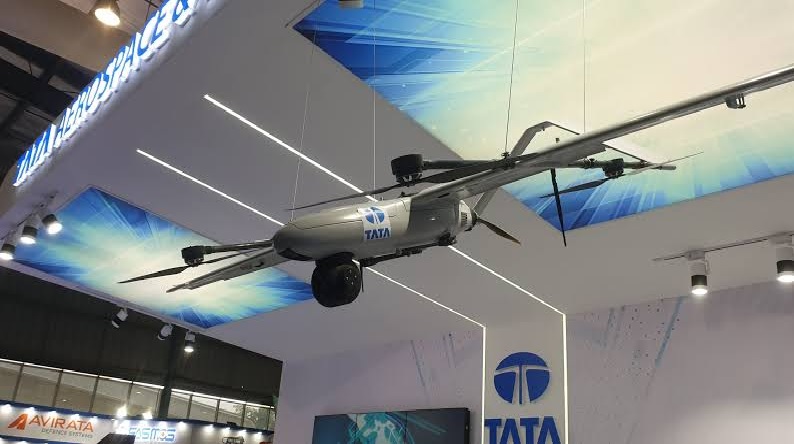Adani Defence Unveils Akshi 7 UAS at Aero India 2025: India’s Next-Gen Tactical Drone for Advanced Warfare

At Aero India 2025, Adani Defence has taken a major leap in the unmanned aerial systems (UAS) domain with the introduction of the Akshi 7, a cutting-edge tactical drone designed for modern warfare and intelligence operations. This UAS is a rebranded version of the Hermes 650 Spark, an advanced multi-role platform originally developed for high-end military missions. The Akshi 7 represents a step towards strengthening India’s defense self-reliance while bringing battlefield-proven technologies under indigenous branding.
A Leap in Tactical Unmanned Systems
The Akshi 7 is built for long-endurance surveillance, precision intelligence gathering, and tactical mission support. Equipped with a powerful satellite communication (SATCOM) link, it can operate beyond the line of sight (BLOS), making it suitable for long-range reconnaissance and strike support missions. With an endurance of up to 24 hours and a flight range of over 300 km in line-of-sight (LOS) mode, the UAS is ideal for border patrol, counter-terrorism operations, and strategic intelligence gathering.
One of the defining features of the Akshi 7 is its modular multi-mission capability. The drone supports a wide array of interchangeable payloads, allowing military forces to customize it for specific missions. Whether conducting electronic warfare (EW), signals intelligence (SIGINT), or surveillance, the Akshi 7 can be adapted in real-time to meet operational needs.
Next-Gen AI-Driven Intelligence
At the core of the Akshi 7 is an AI-powered onboard computing system, which functions as a “server in the sky.” The AI engine enables real-time data processing, target recognition, and predictive maintenance, reducing downtime and improving operational efficiency. This system allows ground commanders to receive instant intelligence updates, ensuring faster decision-making in dynamic combat scenarios.
The drone also integrates machine learning algorithms to enhance autonomous navigation, threat detection, and battlefield coordination. This makes it not only an advanced reconnaissance tool but also a strategic asset in modern network-centric warfare.
Stealth, Agility, and Adaptability
Designed with a low radar signature, the Akshi 7 enhances survivability in contested airspace. It also features automatic takeoff and landing (ATOL) capability, allowing it to operate from short or semi-prepared runways, increasing its versatility in both peacetime and combat missions.
Its multi-sensor payload bay can accommodate electro-optical (EO), infrared (IR), short-wave infrared (SWIR), radar, electronic intelligence (ELINT), and communications intelligence (COMINT) systems. Additionally, the integration of the SkEye Wide Area Persistent Surveillance (WAPS) system makes it an invaluable asset for persistent aerial monitoring of large regions.
Optimized for Cost-Efficiency and Scalability
While advanced in technology, the Akshi 7 has been designed with an emphasis on low operational costs. The UAS requires minimal ground crew and logistical support, reducing overall maintenance demands. Automated pre-flight inspections and self-diagnostic systems further streamline its deployment, ensuring rapid mission readiness with minimal downtime.
With a maximum payload capacity of 260kg, the Akshi 7 is highly adaptable to carrying multiple mission-critical sensors simultaneously. The payloads are distributed across 8 modular storage stations, including 2 payload bays and 6 external hardpoints, enabling seamless mission customization.
A Strategic Asset for India’s Defense Forces
With India focusing on strengthening its indigenous defense manufacturing under initiatives like Atmanirbhar Bharat, the Akshi 7 marks a significant milestone in developing next-generation military UAVs. By adopting the battle-proven Hermes 650 Spark platform under a new Indian identity, Adani Defence is ensuring that the country gains access to world-class UAS technology while maintaining local control over its deployment and integration.
As global conflicts become more tech-driven and intelligence-centric, drones like the Akshi 7 will play a pivotal role in shaping future battlefields. Whether for border surveillance, counter-insurgency, maritime security, or electronic warfare, this advanced UAS promises to be a force multiplier for India’s armed forces.
With its debut at Aero India 2025, the Akshi 7 represents not just another military drone but a vision for the future of Indian air defense technology—autonomous, intelligent, and mission-ready.


